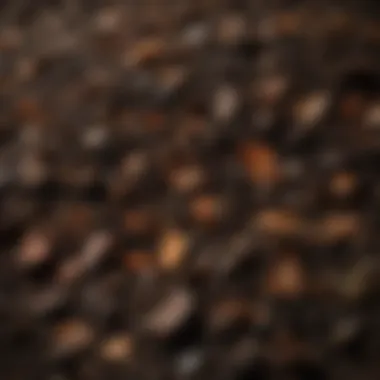Composting Made Easy: Effective Home Techniques


Intro
Composting at home is an essential practice for anyone interested in gardening or sustainable living. It not only helps in reducing waste but also creates nutrient-rich soil that can enhance plant growth. As the world grapples with waste management issues, understanding how to compost effectively has become increasingly relevant. This guide will discuss various techniques, necessary materials, and the ideal conditions for successful composting. In addition to traditional methods, we will explore modern approaches, addressing misconceptions that often hinder people from starting their composting journey.
The goal is to provide readers with a clear and detailed understanding of how to implement composting practices at home.
By the end of this article, you will feel confident in creating your own compost pile, appreciate the environmental benefits, and understand troubleshooting methods for common issues.
The Importance of Composting
Composting is more than just a gardening technique; it is a lifestyle choice. By converting kitchen scraps and yard waste into compost, you can significantly reduce the amount of garbage in landfills. This process not only cuts down on methane emissions, a potent greenhouse gas but also promotes soil health. Rich compost can improve soil structure, retain moisture, and provide essential nutrients to plants, making it a valuable addition to any garden.
Equipped with the right knowledge, you can transform everyday waste into a resource, fostering a healthier environment for future generations.
Prolusion to Composting
Composting serves as an essential practice for anyone looking to manage organic waste effectively while benefiting the environment. The process involves the natural decomposition of organic materials, turning them into a rich, nutrient-dense soil amendment. Not only does this reduce the amount of waste sent to landfills, but it also enhances soil quality, making it an invaluable practice for gardening and agriculture.
Definition of Compost
Compost is a dark, crumbly substance that is derived from the breakdown of organic matter. This matter includes kitchen scraps, yard waste, and various other biodegradable materials. When these items decompose under the right conditions, they create a fertile product that can be mixed into soil to improve its structure and nutrient content. Essentially, composting transforms waste into a resource, closing the loop in the nutrient cycle.
Importance of Composting
The significance of composting extends far beyond merely reducing waste. Here are key points to consider:
- Environmental Impact: Composting helps mitigate greenhouse gas emissions. When organic waste ends up in landfills, it decomposes anaerobically, releasing significant amounts of methane, a potent greenhouse gas. Composting, conversely, happens in the presence of oxygen, significantly reducing harmful emissions.
- Soil Enrichment: Finished compost enhances soil structure, moisture retention, and overall fertility. It provides essential nutrients like nitrogen, phosphorus, and potassium—all crucial for plant growth. Without proper nutrients, plants suffer, and soil becomes less productive.
- Waste Reduction: Composting lowers the volume of waste that households produce. It is estimated that about 30% of household waste is organic material. By composting, individuals and families can significantly decrease their waste footprint.
- Biodiversity Support: Compost also promotes microbial activity in the soil. Healthy soil is alive with microorganisms, which are crucial for maintaining plant health. These organisms help break down organic materials and, in turn, boost plant growth.
"By composting, we reclaim valuable resources, support biodiversity, and foster a healthier planet".
In summary, understanding composting lays the groundwork for creating a sustainable home and garden environment. This knowledge not only contributes to effective waste management but also enriches the soil and promotes a more vibrant ecosystem.
Understanding Organic Material
Understanding organic material is crucial in the context of home composting. Organic materials are the building blocks of compost; they provide the essential nutrients that facilitate the decomposition process and enrich the resulting compost. Without a proper balance of these materials, composting can become inefficient or even fail.
Types of Organic Materials
Greens
Greens refer to nitrogen-rich materials, which are vital for the composting process. They include items like kitchen scraps, grass clippings, and fresh plant trimmings. The key characteristic of greens is their high moisture content, which aids in the decomposition process by providing essential nutrients. This makes them a popular choice in composting. A unique feature of greens is their rapid decomposition rate compared to browns. However, an imbalance with too many greens can lead to a smelly compost pile due to excess nitrogen. Careful management of greens ensures that compost remains effective and pleasant.
Browns
Browns consist of carbon-rich materials such as dried leaves, wood chips, and straw. These materials play an important role by providing structure and aeration to the compost pile. The key characteristic of browns is their lower moisture content, which contrasts with greens. This makes browns a beneficial addition as they balance the nitrogen from greens. A unique feature of browns is their ability to absorb excess moisture, preventing a soggy pile. However, relying entirely on browns can slow down the composting process since they break down more slowly than greens.
Other Compostable Items
In addition to greens and browns, other compostable items can enhance compost quality. Items like eggshells, coffee grounds, and certain paper products can contribute essential minerals and nutrients to the compost. The key characteristic of these items is their ability to provide micro-nutrients and enhance the biological diversity within the compost. Their unique feature lies in the fact that they often are kitchen waste, promoting waste reduction at home. However, care must be taken with certain items, as some can attract pests if not managed properly.
Materials to Avoid
Understanding what materials to avoid in composting is just as critical as knowing what to include. Some materials can introduce toxins or slow down the decomposition process. For instance, meat, dairy products, and oils should be excluded as they attract unwanted pests and contribute to unpleasant odors. Additionally, items treated with chemicals, such as colored paper or certain yard waste, can also lead to toxic build-up in compost.
By being mindful of the materials used, individuals can create efficient and healthy compost that serves its purpose effectively.
The Composting Process
Understanding the composting process is crucial for effective home composting. It outlines how organic materials decompose into nutrient-rich compost, which can greatly benefit your gardening. The process involves several key principles and stages that all work together to create a sustainable cycle of waste reduction and resource reuse.
Basic Principles of Composting
Aeration
Aeration refers to the introduction of air into the compost pile. This aspect is significant as it supports aerobic decomposition, which is the breakdown of organic material in the presence of oxygen. The key characteristic of aeration is that it helps promote the activity of beneficial microorganisms that thrive in oxygen-rich environments. This makes it a popular choice among composters looking for efficient decomposition.


The unique feature of proper aeration is its ability to prevent bad odors and conditions that favor anaerobic decomposition, which can lead to unpleasant smells. Regular turning of the compost pile, or using aeration tools, ensures that air circulates throughout the materials, enhancing breakdown speed. However, if an individual does not turn the pile regularly, anaerobic conditions may form, resulting in slower composting and possible odors.
Moisture Control
Moisture control is another vital principle in the composting process. It necessitates a balance, as too much or too little moisture can hinder decomposition. The main characteristic of moisture control is that it promotes an ideal environment for microorganisms, which require moisture to thrive. Maintaining proper moisture levels makes it a beneficial choice for achieving efficient composting.
Moisture allows for microbial activity, which speeds up the decomposition of organic matter. A unique feature is that the moisture level should resemble that of a wrung-out sponge, ideally around 40-60% moisture content. If too much moisture accumulates, it can lead to a soggy pile that reduces aeration. On the other hand, insufficient moisture can slow down microbial activity. Therefore, regular checks for moisture and adjustment are essential to achieve optimal composting results.
Temperature Regulation
Temperature regulation plays a critical role in the composting process. It indicates the level of microbial activity within the pile. A key characteristic is that the temperature in the compost heap can hint at the effectiveness of the composting process. Higher temperatures, typically ranging from 130°F to 160°F, indicate active decomposition and are a clear sign that the composting process is thriving.
The unique feature of temperature regulation is its influence on pathogen and weed seed suppression. High temperatures can effectively kill harmful pathogens and prevent the growth of unwanted seeds in the final compost product. However, if temperatures become too high, it can lead to a drop in microbial activity if not managed properly. Regular monitoring and maintenance of the pile's temperature is thus valuable in ensuring continued breakdown and compost quality.
Stages of Composting
Initial Decomposition
The initial decomposition phase is the first stage of composting. During this phase, the break-down of organic materials begins. The key characteristic of this stage is the rapid activity of microorganisms, which start to consume the available resources, resulting in heat generation within the pile. This stage is critical for kickstarting the composting process as it lays the foundation for further decomposition.
A unique feature of initial decomposition is the transformation of materials that can take anywhere from a few days to a couple weeks. It can yield an increase in temperature that signifies microbial activity. However, if the materials are not properly mixed or suitable, the breakdown may be inefficient, contributing to a slower process overall.
Active Composting
Active composting is characterized by increased microbial activity and heat generation. During this phase, which typically follows the initial decomposition stage, the pile becomes very active again as microorganisms break down the organic matter further. The crucial aspect of this stage is its ability to significantly reduce waste volume, converting it into compost.
This phase lasts several weeks to months, depending on several factors, including material mix and environmental conditions. Active composting is beneficial because it turns larger, visible organic waste into smaller particles and contributes to the overall composition of the finished product. However, it requires regular turning and moisture checks to ensure sustained activity and prevent anaerobic conditions.
Finished Compost
Finished compost is the final product of the composting process. When the materials have fully decomposed and the pile has stabilized, it indicates that it's ready for use in gardening. The key characteristic of finished compost is its dark, crumbly texture and earthy smell, signifying a successful transformation from raw organic materials.
A unique feature of finished compost is its rich nutrient profile, which can improve soil structure, retain moisture, and provide essential nutrients for plant growth. This makes it a valuable amendment for gardens. However, the downside comes from potential contamination if the composting process wasn't managed properly. Thus, ensuring proper management in the earlier stages is essential to produce high-quality finished compost.
Composting Methods
Composting methods are essential to understand for anyone looking to create effective compost at home. Each method has its own set of benefits and considerations. Some methods are more suitable for small spaces, while others fit larger gardens. Choosing the right system can significantly impact the speed of decomposition and the quality of the final product. By knowing the differences, individuals can select a method that aligns with their needs, available space, and desired results.
Traditional Pile Composting
Setting up a Compost Pile
To set up a compost pile, you need space and commitment. This method typically involves layering organic materials in an outdoor area. The pile should be at least three feet high. This height ensures enough microbial activity for decomposition. A significant advantage of pile composting is that it's inexpensive. No special materials are required. It is also an easy choice for beginners.
However, there are some drawbacks. The process can take time, and managing the pile can be challenging if not monitored. During heavy rain or hot days, the pile may need adjustments to control moisture levels.
Caring for the Pile
Caring for the pile is crucial for effective composting. Turning the pile regularly helps aerate it, promoting quicker decomposition. It also redistributes moisture and material. This is important because without air, anaerobic bacteria dominate, leading to unpleasant smells.
The key aspect of caring for the pile is consistency. Regular monitoring and turning can yield compost faster. An issue might arise if the pile becomes too compacted, which can slow down the process.
Bin Composting
Choosing the Right Bin
Choosing the right bin can influence the composting process significantly. There are various types of bins available, including tumblers, stationary bins, and versatile bin options made from recycled materials. Selecting a bin based on size, material, and open or closed design is important.
An advantageous characteristic of bin composting is that it keeps compost contained. This minimizes mess, deters pests, and allows finer control over moisture and aeration. However, bins can sometimes be more expensive than traditional pile setups.
Benefits of Bin Composting
The benefits of bin composting include quicker processing times and easier management of materials. Since the materials are contained, they often decompose faster than in a traditional pile. Additionally, bins enable better temperature control, which is essential for the composting process.
However, one consideration is that some bins can have a slower decomposition rate. This is particularly true for bins that are not designed for aeration.


Vermicomposting
Prelude to Worm Composting
Introduction to worm composting involves using worms, primarily red wigglers, to break down organic matter. This method creates nutrient-rich compost known as worm castings. It also produces a liquid fertilizer, known as worm tea, which can be beneficial for plants.
Vermicomposting has gained popularity due to its efficiency in small spaces. Worms work quickly, making this method one of the fastest ways to compost. However, it requires careful management. Conditions must be maintained for the worms to thrive.
Setting Up a Worm Bin
Setting up a worm bin is relatively simple. A container with holes for aeration is needed, along with bedding materials such as shredded newspaper or cardboard. Adding kitchen scraps as food keeps worms active and healthy.
A unique feature of worm bin composting is that it can be done indoors. This makes it an excellent choice for people living in apartments or urban areas. Nonetheless, it has downsides. Common issues can include odor problems if too much food is added or if the bin is overwatered.
Tumbler Composting
Advantages of Compost Tumblers
Compost tumblers offer a closed environment for composting, which protects the process from pests and harsh weather conditions. One major advantage is that they encourage faster decomposition. The ability to turn the tumbler easily mixes the materials, ensuring aeration. This method is especially valuable for individuals who may have difficulty managing traditional piles.
However, they do have some limitations. Tumblers can have a smaller capacity than piles, requiring more frequent attention.
Operating a Tumbler
Operating a tumbler is straightforward. Regularly turning the tumbler can enhance aeration and mixing of the compost materials. The active engagement helps the decomposition process move along effectively. It is also vital to monitor moisture levels, as dry conditions can slow down composting.
One downside is the initial cost, as high-quality tumblers can be an investment. Despite this, the efficient and organized nature of tumblers can often be justified through better compost outcomes.
Environmental Considerations
When discussing composting, it is crucial to emphasize the environmental considerations that come with this practice. Composting is not only a means to recycle organic waste but also a vital step toward sustainable living. The aforementioned methods of composting engage in the intricate web of ecosystems and positively impact our planet. Below, we delve into specific elements related to composting and these environmental benefits.
Composting and Waste Reduction
As urban populations grow, waste management becomes a significant concern. Composting directly addresses this issue. By diverting organic materials from landfills, composting reduces the amount of waste that would otherwise contribute to overcrowding and greenhouse gas emissions. In a landfill, organic waste decomposes anaerobically, releasing methane, a potent greenhouse gas.
- Reduces landfill waste: A large portion of household waste includes food scraps and yard waste. Composting can divert up to 30-50% of our waste stream to compost bins instead of landfills.
- Promotes circular economy: Composting allows organic materials to return to the soil, enriching it and closing the nutrient loop. This method supports a sustainable cycle rather than a linear waste-to-landfill process.
Through composting, we contribute to the reduction of waste and promote a more sustainable way of living. It is a small but impactful step toward a cleaner environment.
Impact on Soil Health
Healthy soil is fundamental to vibrant ecosystems. Composting enhances soil health by adding organic matter and nutrients. Finished compost is rich in microorganisms essential for soil vitality. This leads to several benefits:
- Improved Soil Structure: Compost helps to break down heavy soil, allowing better air circulation, drainage, and moisture retention.
- Increased Nutrient Availability: Compost provides essential nutrients to plants, improving growth and resilience.
- Enhancing Biodiversity: The microorganisms present in compost enrich the soil, promoting biodiversity. A diverse soil microbiome is fundamental for a resilient ecosystem.
- Reduction of Soil Erosion: Healthy soil retains moisture and resists erosion better than depleted soil. This is crucial for maintaining land integrity and preventing the loss of fertile topsoil.
"Composting not only feeds our plants but fosters a healthier ecosystem beneath our feet."
Engaging in composting enhances the soil, making it more productive and able to support healthy plant growth. In turn, this contributes to greater biodiversity and resilience within gardens and agricultural lands. By understanding composting's multifaceted role in environmental considerations, individuals can appreciate how it benefits both the planet and their gardens.
Common Misconceptions
Understanding the common misconceptions about composting is crucial for anyone looking to manage organic waste effectively at home. These misconceptions can discourage potential composters from engaging in the practice or lead them to misunderstand the process. By addressing these myths, we can promote a more informed approach to composting. This not only aids in producing high-quality compost but also enhances the overall sustainability of waste management practices at household levels.
Composting Smells Bad
One of the most pervasive myths is that composting produces an unpleasant odor. In reality, well-maintained compost should have a generally pleasant, earthy smell. Bad odors often arise from improper ratios of organic materials, such as too much green material (like kitchen scraps) and not enough brown material (like dried leaves or cardboard).
To avoid foul smells, consider the following:
- Maintain a Balanced Mix: For every part of green material, add about two parts of brown material. This balance provides the necessary carbon-to-nitrogen ratio and supports aerobic bacteria, which are essential for decomposition.
- Ensure Adequate Aeration: Turn the compost pile regularly to keep air circulating. This helps in faster decomposition and reduces the chances of anaerobic conditions, which can produce odors.
- Monitor Moisture Levels: Compost should be damp, not wet. If your compost is too wet, it may start to smell bad. Adding dry browns can help absorb excess moisture.
A well-aerated compost pile can dramatically reduce the risk of bad smells, making composting a more pleasant experience.
Composting Attracts Pests


Another common fear is that composting attracts pests. While it is true that certain pests, such as rodents and flies, may be drawn to food scraps in compost, effective composting practices can minimize this risk significantly.
To deter pests from your compost:
- Avoid Meat and Dairy: These attract unwanted animals like rats and raccoons. Stick to vegetable scraps and other plant materials.
- Cover Scraps: When adding new materials, bury food scraps under existing compost. This helps reduce the smell and makes it less visible to pests.
- Use a Closed Bin: Opt for a compost bin with a lid or a worm bin, especially if you live near areas where pests are a concern. This provides a barrier against potential intruders.
- Keep It Balanced: Just like with odors, maintaining the right balance of materials also helps deter pests. A healthy compost pile is less likely to attract unwanted critters.
By dispelling these common misconceptions, individuals can engage in composting with confidence, knowing they are contributing positively to their environment.
Troubleshooting Composting Problems
Troubleshooting composting problems is an essential aspect of successful composting. It helps identify and address issues that may hinder the decomposition process. Being aware of these potential problems can improve the quality and efficiency of compost produced at home. The benefits of resolving these issues lead to better compost health, thereby enhancing the overall gardening experience.
Composting is not always straightforward, and various factors can influence its success. By understanding common issues, contributors can create the right conditions for optimal decomposition and prevent frustration. Recognizing when something is amiss allows composters to adjust methods effectively.
What to Do If Compost Is Too Wet
If compost becomes too wet, it can lead to a lack of oxygen, causing unpleasant odors and slower decomposition. Signs of over-saturation include a soggy texture and foul smells instead of the earthy aroma of healthy compost. Here are steps to manage a wet compost pile:
- Aerate the Pile: First, use a pitchfork or shovel to turn the compost. Aeration introduces oxygen, which is vital for the microbes that break down organic materials.
- Add Dry Ingredients: Incorporate browns such as dried leaves, straw, or shredded paper. These materials help absorb excess moisture and balance the carbon-to-nitrogen ratio.
- Ensure Proper Drainage: If using a compost bin, check that it has adequate drainage holes. For piles, ensure they are built on well-draining surfaces.
By taking these actions, composters can manage moisture levels and promote a healthy decomposition process.
Dealing with Unfinished Compost
Unfinished compost is another common challenge. When compost is not fully broken down, it can be coarse, contain recognizable organic materials, and may not provide the nutrient-rich benefits desired. To address this issue, consider the following steps:
- Assess the Ingredients: Evaluate the materials used in the pile. High nitrogen content can slow down the process if not balanced with carbon-rich items.
- Continue the Process: Turn the compost regularly to aerate it and stimulate further breakdown. This will help speed up the decomposition process.
- Add Water When Necessary: If the pile appears dry, lightly moisten it to encourage microbial activity. However, avoid making it soggy again.
- Screen the Compost: When using the compost, you can screen out the unfinished pieces. These can go back into a new batch for further processing.
By recognizing the factors leading to unfinished compost and taking action, composters can eventually turn their mixture into nutrient-rich humus for gardening purposes.
Utilizing Finished Compost
Utilizing finished compost is an essential aspect of the composting process. It transforms waste materials into a valuable resource that nourishes the soil and sustains plant life. Understanding how to utilize it effectively can greatly enhance one’s gardening practices. This section covers the best methods for using compost in various gardening scenarios, as well as its role as a soil amendment.
How to Use Compost in Gardening
Compost serves multiple functions in gardening. One of the key benefits is its capacity to provide nutrients without the need for chemical fertilizers. This nutrient-rich material can be incorporated directly into garden beds or used as mulch.
Methods of Application:
- Incorporation into Soil: Before planting, you can mix finished compost into the soil. This enriches the soil structure, improving aeration and water retention.
- Top Dressing: Sprinkle compost on the top of established garden beds. This method enhances nutrient availability and suppresses weeds.
- Compost Tea: Made by steeping compost in water, this liquid can be used to water plants. It delivers nutrients directly to the roots.
By using finished compost, gardeners reduce waste while promoting ecological health. Moreover, plants that are nurtured with compost tend to show better growth and resiliency to pests and diseases. Gardens can become more productive and sustainable as a result.
Compost as a Soil Amendment
Finished compost acts as an organic soil amendment, improving the physical properties of soil. Its application can lead to enhanced soil fertility, texture, and structure. This aspect is crucial for gardeners seeking to optimize their soil health over time.
Benefits of Using Compost as a Soil Amendment:
- Improves Soil Structure: Compost makes soil crumbly and aerated, aiding root penetration and soil microbial activity.
- Enhances Retention of Moisture: It helps soil hold moisture, which reduces the need for frequent irrigation.
- Balances Soil pH: Compost can help to neutralize acidic or alkaline soils, promoting a healthier environment for plants.
- Increases Nutrient Content: Adding compost introduces important nutrients like nitrogen, phosphorus, and potassium, essential for plant growth.
When considering compost as a soil amendment, be mindful of the ratio. It is often recommended to mix compost with existing soil in a ratio of about 1:3 or 1:4, depending on the specific needs of the plants being grown.
Using finished compost is one of the most rewarding practices in sustainable gardening. It not only recycles organic waste but also enhances the health of the ecosystem and promotes plant vitality.
The End
The conclusion of this article highlights the significance of composting. It emphasizes the practical benefits of creating compost at home. In today's world, where waste management is a pressing concern, composting serves as a viable solution. By transforming organic waste into valuable compost, individuals can not only reduce landfill contributions but also enrich their garden soil. This process fosters an understanding of ecological responsibility.
Recap of Key Points
- Definition of composting: Composting is a natural process that recycles organic material, producing a nutrient-rich soil amendment.
- Types of materials: Composting involves greens like food scraps and browns such as dry leaves. Knowing the right mix is essential.
- Composting methods: Various methods exist, from traditional pile composting to modern tumbler designs, making it accessible for different spaces.
- Environmental impact: Composting reduces waste and enhances soil health, contributing to a sustainable ecosystem.
- Overcoming misconceptions: Issues like odor or pests can often be managed with proper techniques, alleviating concerns that might deter potential composters.
Encouragement to Begin Composting
Starting the composting journey may seem daunting, but it is a practical step towards sustainability. Adopting composting practices offers immediate benefits like reducing household waste and improving garden yield. Individuals should not be overwhelmed by the notion that it requires extensive knowledge or large spaces.
"Even small efforts in composting can lead to considerable environmental impact. Every bit counts."
With just a few containers or a small area in your yard, anyone can begin composting. It is about taking the first step and adjusting along the way. Resources and communities are available to assist new composters. Embracing this practice is a way to contribute positively to the environment, and it is achievable for everyone.







